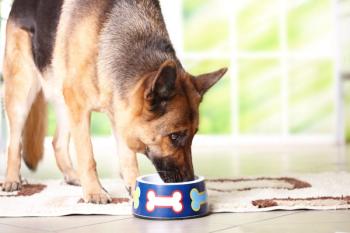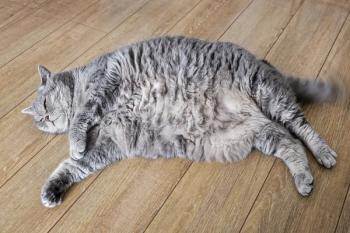
Thinning their portly pets
Sure, Brownie's not as spry as she used to be," says your slightly indignant client, petting her basset hound's bowling ball stomach. "But that doesn't mean that she's not a healthy, happy dog, Doctor."
Sure, Brownie's not as spry as she used to be," says your slightly indignant client, petting her basset hound's bowling ball stomach. "But that doesn't mean that she's not a healthy, happy dog, Doctor."
A 2003 pet obesity survey conducted by Purina reports that out of 79 percent of dog owners who have overweight dogs, only 28 percent think their animal is overweight.
Does this sound like a familiar client reaction to your all-too-common diagnosis of an overweight pet? If so, you're not alone. Studies show that where you see fatal flab, your clients see a pleasantly plump pet. For example, a 2003 pet obesity study conducted by Purina reports that out of 79 percent of dog owners who have overweight dogs, only 28 percent think their animal is overweight. Approaching clients with the issue of pet obesity can be touchy, and it's a problem that is growing to epidemic proportions.
In a 2003 study, the National Research Council found that one out of every four pets in the Western world is obese. In January 2004, Veterinary Pet Insurance, a company with more than 350,000 policyholders, reported a 47 percent increase in cardiac arrest claims in the past two years, with claims for diabetes, hypertension, spinal surgery, and arthritis steadily climbing. Of course, all of these ailments are related to obesity.
Broaching the problem of pet obesity with owners is an issue Dr. Tom McCoy, owner of Harvard Avenue Veterinary Hospital in Tulsa, Okla., took head-on when he started his six-month weight-loss program. To convince clients that their pets need his program, Dr. McCoy uses a positive, nonthreatening approach.
Child and pet obesity are both on the rise
"I gently say the pet's gaining a bit of weight, and then I actually point out the problem areas on the animal while explaining why this extra weight is harmful," Dr. McCoy says. The key is to be direct, yet sensitive. "You can't sound negative or like you're judging your client's lifestyle," he says. "It's got to be, 'Here's what you can do.'"
Barring cases with pathological obesity, such as pets with a hypothyroidism or a tumor, Dr. McCoy finds two causes of overweight pets: The owner is unaware that he or she is overfeeding the pet, or the owner sees the problem but lacks the willpower to stop overfeeding the pet.
The first group is easier to approach, says Dr. McCoy. These "bowl fillers" think that when the dish is empty it must be time to refill it. "In this case, offer a simple ratio comparison. Make sure owners know that what seems like a small amount of food to us is a lot for an animal a fraction of our size," he says. Dr. McCoy recommends making a feeding schedule that sets out how much to feed the pet and when, and then scheduling follow-up appointments to chart the pet's progress until the desired weight is attained.
another morsel
The second group of owners can't separate the love they give their pets with the food they give, says Dr. McCoy. "These people interact with their animals through food; it's a chip for you and a chip for me," he says. They think of their pets as children, rather than as family friends. So denying those big, sad-saucer eyes is just as hard as if they belonged to their actual child, Dr. McCoy says.
Asking these owners to stop doling out treats just doesn't hit home, Dr. McCoy says. You'll need to be a bit firmer, because this is a significant change in the way your client and his or her pet interact. He suggests to:
- Give owners pet weight-ratio handouts that objectively reinforce their pets' proper weight and explain when an animal is overweight and obese.
- Point out the diseases that stem from obesity and explain how the extra weight will diminish their pets' lives.
- Give owners real-life reasons to change their pets' lifestyles. For example, you could try relating anonymous anecdotes about other obese patients and the harmful effects you've seen.
Once you have the owner's attention, suggest that he or she write down what the pet eats and when, Dr. McCoy says. He also suggests that you recommend a reduced-calorie pet food—owners can use this while gradually working down to smaller portion sizes. Also, encourage owners to interact with their pets outside of the kitchen or dining room, he says.
Any recommendations you make to clients need to be confirmed with follow-up appointments, Dr. McCoy says. "When you have such a close bond among owners, pets, and food, sometimes the best weight loss method is constant checking up," he says. Dr.McCoy sends his clients postcards for their follow-up appointment and also makes verification calls.
Dr. McCoy sees his positive approach with owners work, and he's seen the opposite fail. "I used to get up on my soapbox and give a fat pet lecture about the bad state a pet was in," he says. "This approach never got results—people just resented or ignored me. Now I say, 'Here's the problem and the statistics. Let's make this work.' And lo and behold, we do."
—By Marissa Stephenson, Editorial Intern
Newsletter
From exam room tips to practice management insights, get trusted veterinary news delivered straight to your inbox—subscribe to dvm360.






